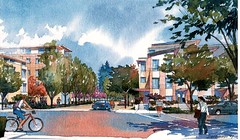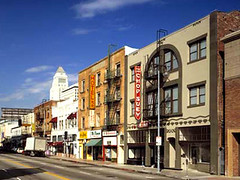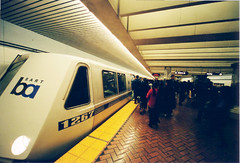How the new California smart growth law will work

Posted October 15, 2008 at 5:19PM
As I've been writing, two weeks ago California governor Schwarzenegger signed landmark legislation to reduce global warming emissions through smarter regional planning and development. This is exciting news for everyone interested in building better communities and more sensible patterns of land use  since, despite the recession, our country's population - and that of California - will continue to grow and need new homes, schools, shops, and workplaces.
since, despite the recession, our country's population - and that of California - will continue to grow and need new homes, schools, shops, and workplaces.
SB375 was strongly supported by NRDC and a diverse coalition of interests including California's League of Cities, Building Industry Association, Association of Counties, and numerous advocates of affordable housing. It was sponsored by state Senator Darrell Steinberg and builds on California's seminal Global Warming Solutions Act, enacted in 2006.
Here's how it will work:
First, the state's Air Resources Board will set greenhouse gas reductions targets for cars and "light trucks" (the definition of the latter is complicated, but it includes most SUVs) in each of California's 18 designated metropolitan planning regions. (Cars and light trucks emit 31 percent of the state's greenhouse gases.)
Then the interesting stuff kicks in. Specifically, each metropolitan planning organization will create a "sustainable communities strategy" that meets the targets.  This will be done by designating growth areas for more efficient housing and commercial development patterns that can reduce automobile dependence through more walking and more efficient public transit, along with shorter driving distances. The land use pattern will be supplemented in the plan by a complementary transportation network. Significantly, the Air Resources Board must certify that the strategy is adequate to meet the targets.
This will be done by designating growth areas for more efficient housing and commercial development patterns that can reduce automobile dependence through more walking and more efficient public transit, along with shorter driving distances. The land use pattern will be supplemented in the plan by a complementary transportation network. Significantly, the Air Resources Board must certify that the strategy is adequate to meet the targets.
(As also noted here, smart planning and investment in Portland has produced a reduction in carbon emissions from 1990 levels, even though the region has experienced an 18 percent growth in population since then. Residents of Portland emit 35 percent less carbon per capita than those of other US cities.)
The sustainable communities strategy must also inventory the region's farmland and wildlife habitat.
 One of the law's key elements is that transportation investments must be consistent with each region's certified sustainable communities strategy, or they will not qualify for funding. But state support will flow to those transportation projects contained in the strategy.
One of the law's key elements is that transportation investments must be consistent with each region's certified sustainable communities strategy, or they will not qualify for funding. But state support will flow to those transportation projects contained in the strategy.
Another key element is that individual residential and mixed-use development projects that are consistent with the certified plan will be exempted from certain analytical requirements normally required by the California Environmental Quality Act, since the relevant analysis will have already been performed in the regional planning process. Moreover, a project found to be a "superior sustainable communities project" under strict environmental and land use criteria will receive further CEQA exemptions.
California also requires housing plans, and those too must be consistent with the regional sustainability strategies.
Once again, kudos to all my colleagues in NRDC's San Francisco office, who have been working day and night on this. And they won't stop, either. The real fun is just beginning, with implementation.
Thanks to my colleague Amanda Eaken for her great analysis of the new law, which helped immensely in writing this post. (A version of this entry was also posted on All Things Reconsidered, the JustMeans blog.)